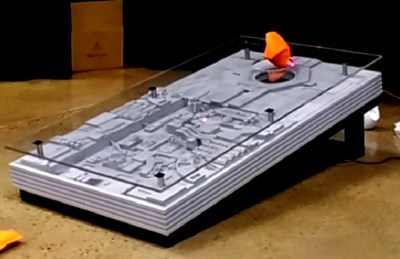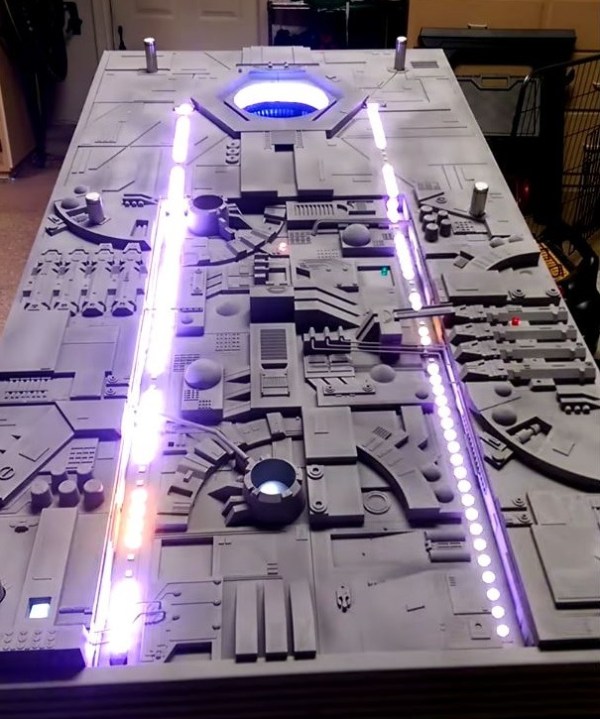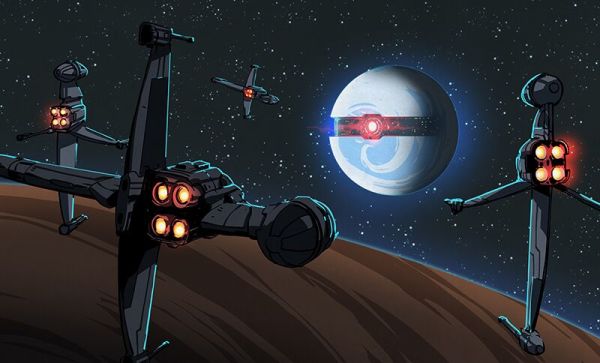After all the fuss and bother along the way, it seems a bit anticlimactic now that the James Webb Space Telescope has arrived at its forever home orbiting around L2. The observatory finished its trip on schedule, arriving on January 24 in its fully deployed state, after a one-month journey and a couple of hundred single-point failure deployments. The next phase of the mission is commissioning, and is a somewhat more sedate and far less perilous process of tweaking and trimming the optical systems, and getting the telescope and its sensors down to operating temperature. The commissioning phase will take five or six months, so don’t count on any new desktop photos until summer at the earliest. Until then, enjoy the video below which answers some of the questions we had about what Webb can actually see — here’s hoping there’s not much interesting to see approximately in the plane of the ecliptic.
death star10 Articles
Can You Bull’s-Eye A Womprat With A Bean Bag?
As it turns out, a simple game of cornhole — aka, bean bag toss — can have some pretty high stakes. If you lose a round playing on this Death Star trench run cornhole table, the Rebel Alliance may pay the price.
 Designed and built by [Hyperdynelabs], the table is set up to play a number of audio clips from the movie with accompanying light effects. Details on how it was made are scant, but there are at least three strips of RGBW LEDs — two that run the length of the board and one inside the exhaust port — an Arduino(presumably), and some sort of wireless connectivity to receive commands.
Designed and built by [Hyperdynelabs], the table is set up to play a number of audio clips from the movie with accompanying light effects. Details on how it was made are scant, but there are at least three strips of RGBW LEDs — two that run the length of the board and one inside the exhaust port — an Arduino(presumably), and some sort of wireless connectivity to receive commands.
But it’s not just the electronic effects that make this one great. The physical build itself really nails the Death Star trench run look. This is thanks to artful use of greebles — it’s the same technique which can turn a Nissan into a Z-Wing.
When you make a shot worthy of Luke Skywalker, you’re treated to an impressive lightshow and the sound of the Death Star exploding. For a particularly bad turn, you can have the table charge up and make a show of firing back, or taunt the player if their shot goes wide.
Continue reading “Can You Bull’s-Eye A Womprat With A Bean Bag?”
That’s No Moon! That’s A Virtual Assistant
[Wisecracker] likes how the Amazon Echo Dot works, but he doesn’t like how they sound or how they resemble hockey pucks. A little 3D printing, though, and he transformed the Dot into a credible Death Star. That doesn’t sound very friendly, we guess, so he calls it Alex-Star.
What makes it work is the Death Star’s “superlaser” — the weapon operated by a console that looks suspiciously like some studio video equipment — happens to be about the size and shape of a two-inch speaker. [Wisecracker] added a slot to let the sound out of the second speaker. You can see the thing in action in the video below.
Continue reading “That’s No Moon! That’s A Virtual Assistant”
Persistence Of Vision Death Star
Death Stars were destroyed twice in the Star Wars movies and yet one still lives on in this 168 LED persistence of vision globe made by an MEng group at the University of Leeds in the UK. While Death Stars are in high demand, they mounted it on an axis tilted 23.4° (the same as the Earth) so that they can show the Earth overlaid with weather information, the ISS position, or a world clock.
More details are available on their system overview page but briefly: rotating inside and mounted on the axis is a Raspberry Pi sending either video or still images through its HDMI port to a custom made FPGA-based HDMI decoder board. That board then controls 14 LED driver boards mounted on a well-balanced aluminum ring. All that requires 75W which is passed through a four-phase commutator. Rotation speed is 300 RPM with a frame rate of 10 FPS and as you can see in the videos below, it works quite well.
Easy Toy Hack Makes Floating Death Star
It always seems odd to us that magnetic levitation seems to only find use in big projects (like trains) and in toys. Surely there’s a practical application that fits on our desktop. This isn’t it, but it is a cool way to turn a cheesy-looking levitating globe into a pretty cool Star Wars desk toy.
As projects go, this isn’t especially technically challenging, but it is a great example of taking something off the shelf and hacking it into something else. The globe covering came off, revealing two hemispheres. A circular hole cut out and inverted provides the main weapon. Some internal lighting and small holes provide light. Some fiber optic sanded and tinted green make the weapon fire. The rest is all in the painting.
There’s even a tiny imperial ship orbiting the killer man-made (or is that Sith-made) moon. If you want a bigger challenge, you might try bamboo. Or you can go minimalist and let your eyes and brain do most of the work.
That’s No Moon – That’s A Bamboo Death Star
At first glance, [Frank Howarth]’s turned bamboo Death Star seems like a straight woodworking project. No Arduino controlled lights, no Raspberry Pi for audio clips of an X-wing attack or escaping TIE fighter. In other words: where’s the hack?
It’s a freaking bamboo Death Star!
If that’s not enough for you, check out the pattern on the surface of the finished model. That’s not painted on – those are the layers of the laminated bamboo lumber used to create the rings [Frank] used to form the structure. After lots of turning, sanding and polishing, the characteristic vascular bundles of the bamboo create light and dark panels for a convincing effect of the Death Star’s surface detail. And although we like the natural finish, we can imagine a darker stain might have really made the details pop and made for an effect closer to the original.
Still not hackish enough? Then feast your eyes on [Frank]’s shop. It’s a cavernous space with high ceilings, tons of natural light, and seemingly every woodworking machine known to man. While the lathe and tablesaw do a lot of the work for this build, the drool-worthy CNC router sees important duty in the creation of the multiple jigs needed for the build, and for making the cutout for the superlaser, in what must have been a tense moment.
Bamboo is an incredible material, whether for fun builds like this or for more structural uses, like a bamboo bike. All this bamboo goodness puts us in the mood to call on [Gerrit Coetzee] for a new installment on his “Materials You Should Know” series.
Continue reading “That’s No Moon – That’s A Bamboo Death Star”
The Scientific Implausibility Of Starkiller Base
This post contains spoilers for Star Wars: The Force Awakens. These spoilers won’t affect you if you haven’t seen the movie; they’re equivalent to saying, “in A New Hope there’s a moon sized battle station with a superlaser” and “someone gets a hand amputated with a lightsaber in a Star Wars movie”
A lot has happened in the Star Wars universe since the battle of Endor. The Empire is in ruins, and Yavin 5 and the forest moon of Endor both have new planetary ring systems. The Rebellion has given way to a new Galactic Republic, but there is a spectre of evil looming in the unknown areas of the galaxy: the First Order, a malevolent force that has built a planet-sized superweapon capable of destroying entire planetary systems from across the galaxy. The Starkiller gets its energy from harvesting entire suns, moving from one solar system to another to feed this massive weapon of terror.
We’ve had nearly forty years to argue the plausibility of the Death Star, lightsabers, parsecs as a unit of time, and hyperdrives. It’s time to pass the hallowed tradition of arguing over fictional spacecraft to a new generation. Starkiller Base is a cool idea, but does the science behind it hold up? No. It’s completely implausible. It makes for a great story, but it’s completely implausible.
Continue reading “The Scientific Implausibility Of Starkiller Base”


















